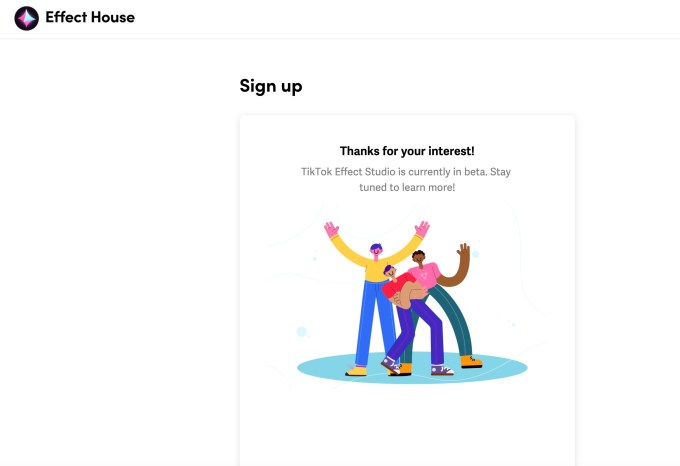Both Facebook and Snap offer tools that allow developers to build out augmented reality (AR) experiences and features for their own respective family of apps. Now, TikTok is looking to do the same. The company recently launched a new creative toolset called TikTok Effect Studio, currently in private beta testing, which will allow its own developer community to build AR effects for TikTok’s short-form video app.
On a new website titled “Effect House,” TikTok asks interested developers to sign up for early access to Effect Studio.
On the form provided, developers fill out their name, email, TikTok account info, company, and level of experience with building for AR, as well as examples of their work. The website also asks if they’re using a Mac or PC (presumably to gauge which desktop platform to prioritize), and whether they would test Effect House for work or for personal use.
The project was first spotted by social media consultant Matt Navarra, via a tip from Sam Schmir.
TikTok confirmed to TechCrunch the website launched earlier in August, but the project itself is still in the early stages of testing in only a few select markets, one of which is the U.S.
The company couldn’t offer a timeframe as to when these tools would become more broadly available. Instead, TikTok characterized Effect Studio as an early “experiment,” adding that some of its experiments don’t always make it to launch. Plus, other experiments may undergo significant changes between their early beta phases and what later becomes a public product.
That said, the launch of an AR toolset would make TikTok more competitive with industry rivals, who today rely on creative communities to expand their apps’ features sets with new features and experiences. Snap, for example, launched a $3.5 million fund last year directed toward Snapchat AR Lens creation. Meanwhile, at Facebook’s F8 developer conference in June, the company announced it had grown its Spark AR platform to over 600,000 creators across 190 countries, making it the largest mobile AR platform worldwide.

Image Credits: screenshot of TikTok website
TikTok, too, has been increasing its investment in developer tools over the past couple of years. However, its focus as of late has been on toolkits aimed at third-party developers who want to integrate more closely with TikTok in their own apps. Today, TikTok’s developer website provides access to tools that allow app makers to add TikTok features to their apps like user authentication flows, sound sharing, and others that allow users to publish videos from a third-party editing app out to TikTok.
The new TikTok Effect Studio isn’t meant to be used with third-party apps, however.
Instead, it’s about building AR experiences (and possibly, other creative effects), that would be provided to TikTok users directly in the consumer-facing video app.
Though willing to confirm its broader goals for TikTok Effect Studio, the company declined to share specific details about the exact tools may be included, citing the project’s early days.
“We’re always thinking about new ways to bring value to our community and enrich the TikTok experience,” a TikTok spokesperson told TechCrunch. “Currently, we’re experimenting with ways to give creators additional tools to bring their creative ideas to life for the TikTok community,” they added.
